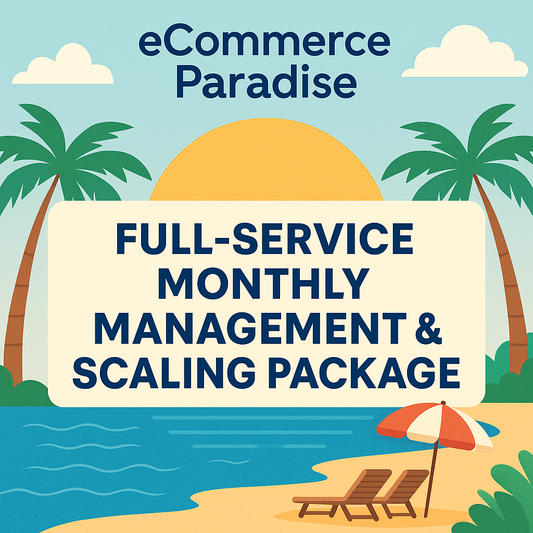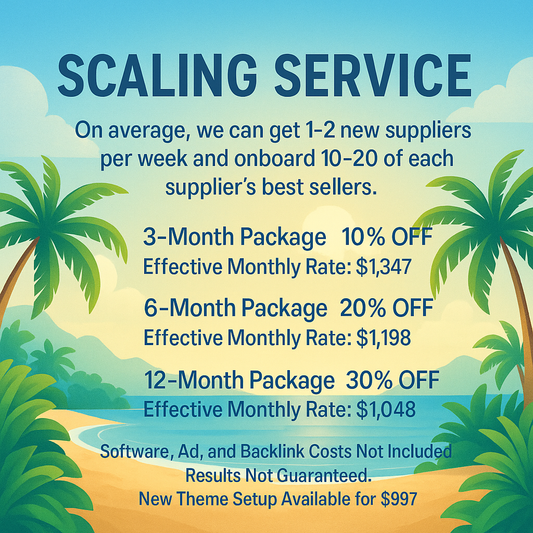How to Turn SEO Into a Scalable Growth System for Your Shopify Store
What to do after your SEO is set up — and how to keep the traffic growing
If you’ve gone through the full process of optimizing your Shopify store for SEO — from keyword research and on-page optimization to content marketing and backlinks — you’re already ahead of the game.
But here’s what separates the top ecommerce stores from the rest:
They treat SEO like a system, not a one-time setup.
In this final post of the series, I’ll walk you through how to turn everything you’ve learned into a repeatable growth system you can maintain, scale, and even outsource.
Why You Need an SEO System
SEO is powerful — but only if you stick with it. The stores that keep growing are the ones that stay consistent, monitor performance, and keep optimizing over time.
A system allows you to:
-
Regularly publish and promote new content
-
Easily update and improve your most important pages
-
Track rankings and spot opportunities
-
Delegate tasks to a VA or content writer
-
Focus on growth instead of constantly starting over
What an SEO System Looks Like in Practice
Here’s how to turn all your hard work into a smooth, scalable process:
1. Create a Simple Content Calendar
Plan 1–2 blog posts per month around your products, collections, and customer questions. Schedule content seasonally, around promotions, or based on keyword opportunities.
2. Build a Repeatable SEO Checklist
For every new product, blog post, or collection page, follow a checklist that includes:
-
Keyword research
-
SEO title and meta description
-
Structured headings and on-page copy
-
Alt text for images
-
Internal linking to related pages
-
FAQ section or customer reviews
-
Schema markup
Use this same checklist every time to save mental energy and improve consistency.
3. Assign and Delegate SEO Tasks
You don’t have to do everything yourself. Many SEO tasks can be handled by a trained virtual assistant or contractor.
Common SEO tasks to outsource:
-
Blog writing
-
Image optimization
-
Schema markup setup
-
Link building outreach
-
On-page SEO updates
-
SEO audit reporting
You can hire once, train once, and let the system run on autopilot with minimal supervision.
4. Track Progress Monthly
Use Google Analytics and Google Search Console to review:
-
Organic traffic trends
-
Top-performing and declining pages
-
Keyword rankings
-
CTR and impressions
-
Pages needing updates or re-optimization
Set a reminder to do a monthly SEO check-in. Keep a dashboard or tracking sheet with your top 10–20 pages and their key metrics.
5. Set Quarterly Goals
SEO takes time. Setting 90-day goals helps you stay focused and track real growth.
Here are some SEO goal examples:
-
Publish 6 new blog posts
-
Improve ranking of 5 collection pages
-
Acquire 10 backlinks
-
Increase organic traffic by 20%
-
Reduce page load time by 1 second
-
Hit top 5 rankings for 5 target keywords
Make it simple and achievable — then build on your wins.
6. Re-Optimize Existing Content
Google loves fresh content. Revisit your older blog posts, product pages, and collections every few months.
Update them with:
-
Better images
-
New copy
-
Additional FAQs
-
Internal links
-
Schema updates
-
CTAs or new offers
Just 2–3 updates per month can make a huge difference in long-term traffic.
7. Systemize the Repetitive Stuff
Anything you find yourself doing more than twice can probably be:
-
Turned into a template
-
Made into a SOP (standard operating procedure)
-
Outsourced to a trusted VA
-
Automated with a tool or app
This keeps you out of the weeds and focused on strategy and scaling.
SEO as a Growth Engine
Once your system is in place, SEO becomes a growth engine that works while you sleep.
You’re building long-term traffic assets that attract leads, customers, and sales — without paying for ads or chasing the next hack.
And as you grow, this system can scale across:
-
New product lines
-
New stores
-
New brands
-
Even clients, if you run an agency or consulting business
SEO Growth System Checklist
-
Blog content calendar set for the next 30–90 days
-
SEO checklist created for all new pages
-
VA or contractor trained on SEO tasks
-
Analytics dashboard reviewed monthly
-
Quarterly SEO goals set and tracked
-
Old content updated regularly
-
Templates/SOPs created for repeat tasks
Want Help Putting It All Together?
If you want help building your own SEO system — or want to work with us to get it done faster — check out the options below.
Download the Ultimate SEO Checklist
Book a Free SEO Strategy Call
Join the Ecommerce SEO Course + Discord Membership
You’ve now completed the full Ecommerce SEO training series. If you made it this far — you're serious about growing your store. Let's keep it going.


















